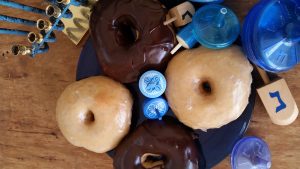
Double Your Impact for the Holidays
Double Your Impact for the Holidays
Your urgently needed year-end gift can go twice as far to provide care and support and accelerate Alzheimer's research this holiday season — and all year long. Show your giving spirit today during this 2x Match Challenge.
Donate NowWe are at a crossroads. Should we give Mom anti-psychotic medication to combat her hostility and irrational behavior (i.e., hallucinations, delusions, aggression, agitation), thereby knowingly accepting possible side effects of these drugs? Or should we continue to shepherd Mom through her heartbreaking performances and embrace her anger?
Mom is regressing into a world of incoherence and fantasy. She experiences what my dad calls psychotic episodes between periods of greater clarity with lack of cognition and total memory loss.
The use of anti-psychotic drugs must be considered with extreme caution. No drugs are specifically approved by the U.S. Food and Drug Administration to treat behavioral and psychiatric dementia symptoms in people with Alzheimer’s, though “off-label” use, where a doctor prescribes a drug for a different purpose than the one for which it is approved, is an accepted practice. How much is too much agitation? What defines a hallucination? Are there other alternatives? What are the risks involved? Is Mom a danger to herself or us? Who are the drugs really for—her or us?
We know from past experience that even a very low dose of one of the recommended drugs slows Mom’s gait, makes her sleepy and her speech more incoherent. But she is also more compliant and generally happy.
My dad is the one who spends all day every day with Mom. He has little time for himself, and he is often in conflict with Mom over her behavior. I had a renewed sense of his experience when he was out of the house for the whole day, and I was the key caregiver.
Several times during the day, Mom told me she had to leave. She walked to the back of the house and went from one room to the other. In Daddy’s studio, she went into the corner and dramatically pressed along the wall as if looking for a secret passageway. Back in the hall, she fumbled with the sliding door, trying to figure out how to open it. Then she went into the study, stood by the desk examining what was on it, opened the file drawer, and rummaged through it. I walked with her on several of her circuits, surprised at one point to find a folded manila folder under her skirt.
The first time it happened, it was only 8 a.m., too early to head to the local mall. I took the advice of our Filipina caregiver Sahli and let Mom struggle on her own. If we didn’t talk to her, she seemed less angry. But I was heartbroken to watch her actions knowing I could not help her or calm her in any way. When it was late enough to walk out, Mom hesitated. She told me she needed to stay where she was to find the way home. When I showed her the door at the other end of the apartment, she reluctantly followed me out.
We had a great time walking and talking, drinking coffee, window shopping, visiting rabbits in the pet shop and commenting on the people around us. On our walk home, Mom continued to radiate happiness. We stopped at my house and ended up making doughnuts for Chanukah. We listened to Benny Goodman, sat in the sunshine, swung our legs on the bed and laughed about everything. Mom cooed over the cat. Then she lovingly pet my stuffed moose, asking me at one point if it had trouble breathing.
At about noon, we went back to Mom’s house.
“This isn’t my house,” she said when we went inside.
And so began Mom’s second round of “going home.” She refused to eat lunch. She refused to take her nap. We checked up on her occasionally, but our idea was that she’d eventually tire and want to sleep.
At 1:00, I asked if she’d like to come back to my house to bake the doughnuts (they had to rise for an hour). Nope. Mom expressed an urgency to stay where she was. I left her with Sahli and popped home.
I was back by 1:30. I took Mom into her bedroom thinking I could convince her to nap by lying down with her. Ha ha. Mom examined everything in the room. She sat at the edge of the bed and made her skirt into a kind of pocket so that she could put things she’d gathered in it. Of course, the minute she stood up they all fell out. So she took off her skirt. She found a sweater and put it on over her other two layers. She took it off, put her skirt back on, then put on one of Daddy’s sweaters. She placed things under her pillow, including her purse, some tissues, a file from the computer room and Daddy’s sweatpants. All the while she kept up a running commentary on everything that she was doing. Most of it involved saying goodbye to me and kissing the top of my head because she was apparently heading off into the wild unknown.
Two hours later, we left her room. Sahli finally got her to sit down, and then miraculously, her mood changed. She ate lunch, had a cup of tea, talked and giggled, and somehow seemed to gain a modicum of normality. By then, thankfully, it was time to pick Daddy up at the train station.
What a greeting Daddy received. Here was Mom’s sun returned to her.
“I bet you’re glad I’m home,” he quipped.
And I was.
As to the drugs, it is not my decision to make. But I guess you know how I feel. I don’t want to lose any part of Mom that can interact with us with joy and laughter. I realize that this opinion may come at a steep price.
Chanukah, oh Chanukah. Doughnuts are the least interesting part of Chanukah historically, but they are synonymous with the modern-day holiday. The trick is to eat doughnuts without gaining a million pounds. Here’s a sensible recipe that I made especially for my dad.
Saba No-Fry Doughnuts
I made these doughnuts specifically for my dad—no milk, no fried dough. He deserves a special treat. They came out reasonably well; they give the illusion of eating a doughnut. The less you knead the dough, the spongier the doughnuts turn out.
2 teaspoons yeast ½ cup sugar ¾ cup warm soy milk 4 eggs ½ cup oil 3¾ cups flour 1 teaspoon salt 1 teaspoon vanilla
Icing:
1½ cups powdered sugar 2-3 tablespoons soy milk 1½ teaspoons vanilla For chocolate icing, add 2½ tablespoons baking cocoa
Directions:
Proof yeast in a small bowl by adding yeast, sugar and warm soy milk. Let react for 15 minutes. Add eggs and vanilla. Sift in flour and salt. Knead till dough forms. Let rise for two hours in a warm area. Refrigerate dough overnight, or up to two days.
Remove from fridge and shape as follows: Without kneading the dough, make fist-sized balls and place on a baking tray covered in baking paper. Use a small, round cookie cutter or other item to make the doughnut holes. When all the doughnuts are made, cover with a towel and let rise for up to an hour in a warm area. Brush tops with egg and bake at 375° for 15 minutes. Meanwhile, in a separate bowl, mix icing ingredients. Dip warm doughnuts in icing then let cool. Microwave for 15 seconds just before eating.
About the Author: Miriam Green writes a weekly blog at http://www.thelostkichen.org, featuring anecdotes about her mother’s Alzheimer’s and related recipes. Her poetry has appeared in several journals, including Poet Lore, the Prose Poem Project, Ilanot Review, The Barefoot Review and Poetica Magazine. Her poem, “Mercy of a Full Womb,” won the 2014 Jewish Literary Journal’s 1st anniversary competition. She holds an M.A. in Creative Writing from Bar Ilan University and a B.A. from Oberlin College. Miriam is a 20+-year resident of Israel and a mother of three. Her parents recently moved down the street from her.
Learn More:

The first survivor of Alzheimer's is out there, but we won't get there without you.
Donate Now
Learn how Alzheimer’s disease affects the brain.
Take the Brain Tour
